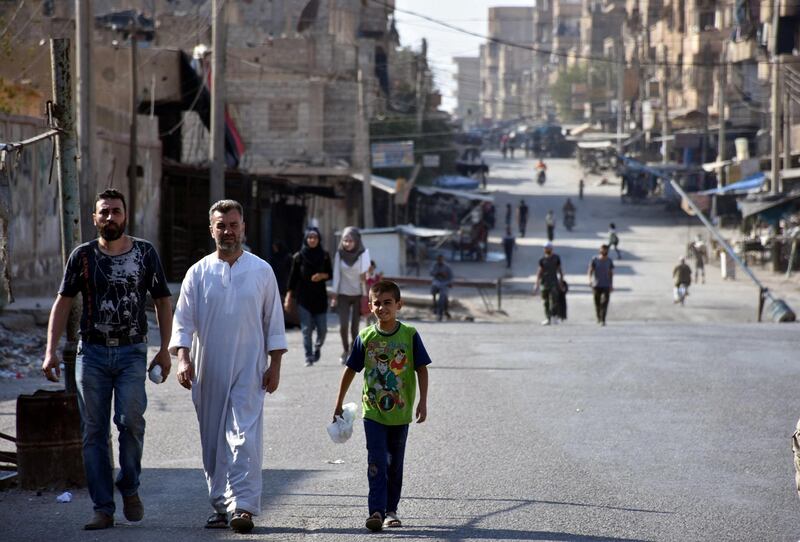Beirut // The Syrian government is preparing for a major offensive against the city of Deir Ezzor, one of ISIL’s last strongholds in the country, after a string of victories that have reshaped the contours of the conflict.
The announcement of the offensive comes after Syrian government troops backed by Russian air support and allied militia broke a nearly year-long siege on a military airport to the west of the city on Monday. The victory built on the breaking of another siege last week against a nearby military base, that had lasted for years.
Meanwhile, Hizbollah leader Hassan Nasrallah added his voice to the chorus of those claiming victory for Syrian president Bashar Al Assad and his supporters in Syria’s six-year-old civil war.
"Our martyrs, our wounded, our families and our people change equations and make the history of the region, not the history of Lebanon," according to Lebanese newspaper Al Akhbar on Tuesday. "We have won the war ... and what remains are sporadic battles."
The Lebanese militant group has fought on the side of Mr Al Assad’s government since 2013, becoming an essential part of beating back rebels and helping the government reclaim its territory. The newspaper said Mr Nasrallah made his remarks during a private function on Monday.
Russian Lt Gen Alexander Lapin told reporters on Tuesday that the Syrian government now controls 85 per cent of the country’s territory. Russia has been providing air support for the government since 2015.
The claim appeared to be an exaggeration: US-backed Syrian Democratic Forces have recently captured much of the city of Raqqa, as well as the surrounding area.
Rebels also hold most of Idlib Province in north-western Syria, and clashes still take place on a daily basis in most of the country’s 14 provinces. ISIL also still remains in control of significant parts of eastern Syria, and has recently put up stiff resistance against a Syrian government offensive near Hama, in central Syria.
The Syrian government’s offensive will probably bring it into closer proximity with US-backed forces. The SDF, with the support of US airpower and artillery, is moving toward Deir Ezzor from the north.
The US and Russia currently observe a line of de-confliction that runs roughly along the Euphrates River, with Russia backing forces on the west side of the river and the US on the east.
The de-confliction line could shift in the coming weeks, Colonel Ryan Dillon, spokesman for the US-led military coalition in Iraq and Syria, said.
“We have been in discussion with the Russians as to where the line needs to go to now as we push into this ISIL held territory,” Col Dillon said. “That line is being drawn on a daily basis, and then we have the telephone line we talk on nearly every day, from ground commanders to air component commanders, to the commander that runs our side, Lt Gen (Paul) Funk.”
Andrew Tabler, a fellow at the Washington Institute for Near East Policy, said the US had indirectly made the Syrian government’s gains possible by helping negotiate ceasefires in other parts of the country.
“The recent offensive was made possible by the de-escalation agreement in the south-west brokered by the US and Russia. It allowed the regime to withdraw its armored divisions out toward Deir Ezzor,” Mr Tabler said. “The difficulty for the regime comes in holding the east. The settled tribes and other residents in the Euphrates Valley know that the forces pulling up from the west isn't the Assad regime of old, but a new Iranian- and Shia- influenced force.”
While an offensive may be imminent, it will not necessarily bring about a decisive result. In the push towards Deir Ezzor through central Homs province in recent months, Syrian government forces recaptured cities that have changed hands more than once.
Underscoring that dynamic, government announcements that ISIL was on the verge defeat in Hama province last week appear to have been premature.
The Syrian Observatory for Human Rights, which monitors the conflict, said on Monday that pockets of ISIL fighters had pushed back against government troops who are trying to secure a stretch of the country’s main highway.
The Observatory also reported on Tuesday that Russian airstrikes around Deir Ezzor killed at least 62 civilians in three days of fighting. The Observatory said that the strikes had hit camps for displaced people and boats taking civilians across the Euphrates River.
“Citizens use ferry boats to travel between the western and the eastern banks of the Euphrates River, after most of the bridges over the river had been shelled,” the Observatory said.
The observatory has recorded nearly 500,000 civilian and combatant deaths in the conflict.
*Additional reporting by Associated Press





